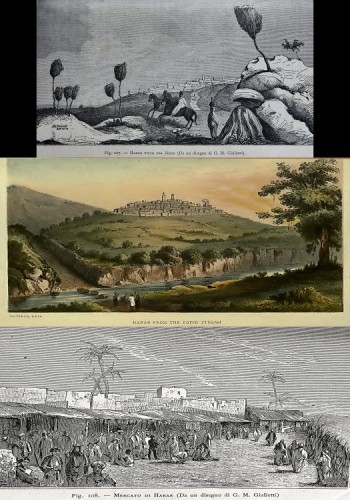THE EXHIBITION
WITHIN THE WALLS OF HARAR
 About 500 km east of Addis Ababa is Harar, one of the oldest Muslim cities of East Africa. The area, first occupied probably starting from the 9th century, was the capital city of a historical emirate on the crossing of important trade-routes. Captured by the Egyptians during their expansionist drive in northeast Africa in the 1870s, the city intensified its commercial activities and the yearly circulation of caravans between Harar and the coast increased from 70 to 400 during Egyptian occupation. In 1887 the army of king Menelik II incorporated it into the expanding Ethiopian empire.
About 500 km east of Addis Ababa is Harar, one of the oldest Muslim cities of East Africa. The area, first occupied probably starting from the 9th century, was the capital city of a historical emirate on the crossing of important trade-routes. Captured by the Egyptians during their expansionist drive in northeast Africa in the 1870s, the city intensified its commercial activities and the yearly circulation of caravans between Harar and the coast increased from 70 to 400 during Egyptian occupation. In 1887 the army of king Menelik II incorporated it into the expanding Ethiopian empire.
While the importance of Harar as a regional commercial centre was superseded by Dire Dawa with the construction of the Addis Ababa–Djibouti railway in the early 1900s, its cultural prominence still plays a significant role as it is considered the major centre of Islamic learning in the Horn of Africa.
The beautiful, old city comprises a clearly defined area of 1.6 sq. km. It is surrounded by a 4.5-metres-high wall (gugal), built during the 16th century, and accessed by five doors (bari). The town is divided into five quarters, adjacent to the gates and bearing the latters’ names. Each quarter is in turn divided into neighborhoods, and every neighborhood is composed of several household compounds. In addition, there exists another division of the town into “seven circles of holiness”, the inner circle around the square of Faraz Magala – “The horse market” – the main piazza, being the holiest one. A second market, also called Gidir Magala (“Big Market”) is located in the middle of the town where four of the quarters meet.
The city owns about a hundred mosques. In 1990s, more than 200 shrines and holy sites of the saints were recorded in the city, which greatly vary in their shape: from trees, rocks, small niches in the walls of the houses or mosques to big domed structures.
The Harari are the urban population of the city of Harar. They are a homogenous population with a strict preference for endogamy, uniform adherence to Sunni Islam, and a long history as both wealthy landowners, growing the lucrative crops of the famous Mocha coffee and cat on some of the most fertile land in Ethiopia, and as merchants controlling trade in local and imported goods. The historical literature suggests that the Harari are in fact multi-ethnic in origin, most likely the result of intermarriage between Arab, immigrants arriving between the 9th and 12th century, and local residents. Local religious practices are syncretic, and include the reverence of saints, whose shrines are found within and beyond the city walls. A good number of these saints are female, lending support to the idea that pre-Islamic ancestral worship was not wiped out by the arrival of Islam, but rather reconceived and incorporated into a Muslim framework.
People living in Harar, have produced a considerable body of written literature, religious and non, in Arabic and in their own language (Harari). Oral tradition reports that texts and manuscripts have existed which were written in an ornamental secret script traditionally called Suriyani (Syrian) script or “Ibrahim’s Alphabet”. Very few of these texts are preserved. Tradition suggests that it had been probably used as a secret writing-system among local Harari scholars and students.
Walking today along the narrow, cobble-paved streets of old Harar is like moving in a colorful meltin’ pot of faces and sounds. Here, persons of ethnic Amhara, Oromo, Harari, Gurage or Somali backgrounds and different cultures coexist with a high degree of religious tolerance so that in 2002–03, Harar received the UNESCO Cities for Peace Prize for urban harmony.























